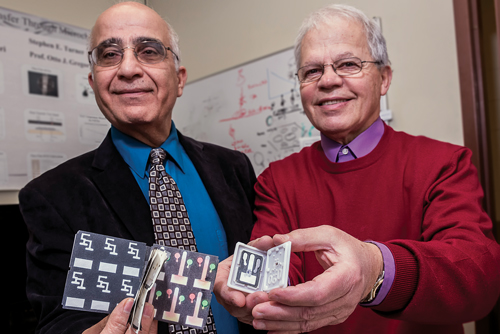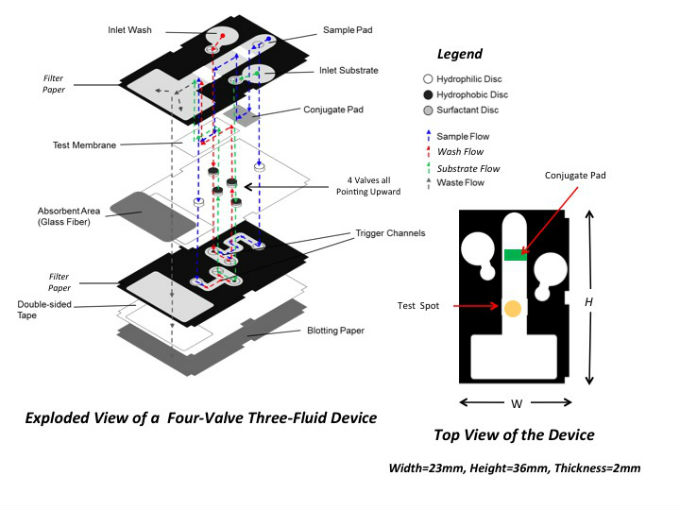New diagnostic capabilities could enable clinical laboratories to obtain multiple outcomes on single fluidic strip tests
Researchers at the University of Rhode Island (URI) have developed a paper-based microfluidic valve technology that some claim may revolutionize existing lateral-flow tests. There is the potential for this innovation to eventually enable pathology groups and medical laboratories to conduct a wide variety of complex medical diagnostics on single fluidic test strips, such as those used to diagnose pregnancy and strep throat, according to a university statement.
Testing Multiple Biomarkers Using a Single Test Strip
Fluidic test strips commonly in use today are generally capable of rendering only one result. However, by combining their new paper-based valve platform with standards strip tests, the URI research team has produced strip tests capable of answering more challenging medical questions.
The evolution of the new technology, dubbed “Lab-on-Paper,” follows the development of the team’s earlier “lab-on-a-chip” device, which the researchers began developing back in 2005.
To explore the opportunities to commercialize the new Lab-on-Paper technology, the developers created a start-up company called Labonachip, LLC. This new company will focus on creating “paper-based multireagent diagnostics” and “diagnostics without the lab,” according to the company’s website.
To create this new technology, the researchers brought three elements together. “We combined the well-established test strip technology, micro-patterning techniques, and our innovative paper-based valves, to create a new class of strip tests that are capable of autonomously handling multiple reagents,” stated Mohammad Faghri, PhD, Professor, Mechanical Engineering and Applied Mechanics at URI. Faghri led the Lab-on-Paper research.
New Lab-on-Paper a Boon to Remote Diagnostics in Resource-poor Locales
Pathologists and medical laboratory executives will no doubt admire the tenacity of the URI team. Since the new class of strip testing does not require expensive equipment or trained caregivers, it could become a cost-effective resource to providers and others in remote or resource-challenged environments.
According to a Labonachip press release, “The key development was the invention of fluid-actuated valves embedded in the paper that allow for sequential manipulation of sample fluids and multiple reagents in a controlled manner to perform complex multi-step immune-detection tests without human intervention.”
The researchers envision it becoming significant in the diagnosis of HIV, Ebola, Lyme disease, and Malaria the researchers stated in the news release. Its potential applications, they said, may extend to veterinary medicine and environmental contaminants, as well.
Going with the Lateral Flow
Researchers had a hunch that paper-based lateral flow, such as those used for pregnancy diagnosis, could do more. Such a test works as a sample fluid wicks along a paper strip. It reacts with embedded reagents and signals positive or negative with a color—pink if the individual is pregnant and blue if she is not (in many home pregnancy test designs).
But more complex medical diagnostics require something additional. Specifically, the researchers’ challenge was to fashion miniature technology to trigger multiple reagents at specific times during the process. Ultimately, microfluidic valve technology emerged as the secret behind the University of Rhode Island research team’s new test strip design.
“It’s like plumbing. We have invented a valve on paper. We do it without any pumps. We’re the only research group in the world to have created fluidic values and circuits on multi-layer paper without the use of external mechanical, electrical, or magnetic force,” stated Faghri in a Providence Journal article.

University of Rhode Island engineering professors Mohammad Faghri, PhD (left), and Constantine Anagnostopoulos, PhD (right), show their Lab-on-Paper test that they say can handle multiple reagents and enable rapid and inexpensive medical diagnostics. (Photo and caption copyright: University of Rhode Island.)
How Does It Work?
Fluid-activated valves are embedded in paper and allow for sequential manipulation of sample fluids and the multiple reagents necessary to perform complex testing. Here are details on how Lab-on-Paper works, as noted by Comsol, a software solutions for multiphysics modeling company:
• Multi-layered paper was printed with wax;
• These new strips feature fluid-activated valves;
• Paper-based valves enable orderly manipulation of sample fluids and multiple reagents;
• Valves create fluidic circuits prompting reagents to move;
• Reagents move in a particular sequence and at a certain time;
• The new micropump feature helps fluid move through microchannels.
“The sample fluid activates the flow of reagents in a predetermined sequence and time. When combined with an optical reader—which could even be a smartphone—the Lab-on-Paper device provides accurate quantitative results. It can perform enzymatic assays on paper autonomously with sensitivities close to laboratory techniques,” Faghri said in the university statement.

The Lab-on-Paper is made with multiple layers of paper printed with wax to create a three-dimensional structure of values and channels along which the fluid travels, the URI statement explained. (Photo and caption copyright: University of Rhode Island Research Foundation.)
More Diagnostic Applications Possible
The platform technology has potential applications for a wide variety of medical diagnostics, in the veterinary medicine field, and for use in detection of environmental contaminants and biological or chemical threats, according to its developers. And a patent has been issued by the U.S. Patent and Trademark Office for the technology.
“It could change diagnostics as we know it,” noted Constantine Anagnostopoulos, PhD, Adjunct Full Professor, Mechanic Engineering and Systems Engineering, URI, in the Providence Journal article. Anagnostopoulos collaborated on the research and serves as president of Labonachip, LLC, which he said is looking for medical or biological company partnerships in disease biomarker identification.
He could be right about transforming diagnostics. This easy-to-use technology may be emerging just as point-of-care testing penetrates healthcare. Pathologists and laboratory executives may not have to wait another five years until they hear from this research team again.
—Donna Marie Pocius
Related Information:
Researchers Invent Lab-on-Paper for Rapid, Inexpensive Immune Detection Tests
URI Invents Fast Inexpensive Blood Test
At URI, a Lab on a Paper Square
Rhode Island University Paper-Based Mini Lab



